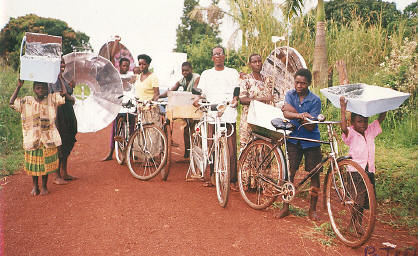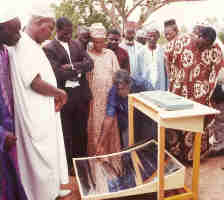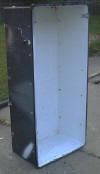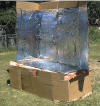| Solar Cookers International... 1919 21st Street, #101 Sacramento, CA 95811 USA Tel. 916-455-4499 Fax 916-455-4498 E-mail: info@solarcookers.org |
Solar Cooker Review November 2001 |
Solar Cooking
Archive: |
|
Volume 7, Number 2 |
|
In This Issue
Africa and Europe
Benin
 Using SCI literature, Mr. Vincent Nnanna successfully constructed his first
solar box cooker last year. Since then, he has been busy building other cookers
and conducting workshops. One of those workshops was conducted for 12th grade
students at the International School of Benin. With assistance from Mr. Otumo, a
science teacher, Mr. Nnanna taught the students how to make and use solar box
cookers. In the future he hopes to teach refugees living in Benin how to solar
cook.
Using SCI literature, Mr. Vincent Nnanna successfully constructed his first
solar box cooker last year. Since then, he has been busy building other cookers
and conducting workshops. One of those workshops was conducted for 12th grade
students at the International School of Benin. With assistance from Mr. Otumo, a
science teacher, Mr. Nnanna taught the students how to make and use solar box
cookers. In the future he hopes to teach refugees living in Benin how to solar
cook.
Contact: Vincent Nnanna, c/o B.P. 2019, Cotonou, Benin. E-mail: vinfish@hotmail.com
Gambia
The Earth Saver Club’s Solar Cooker Project 2020 has now entered its second phase. During the first phase, at least half of the residents of Central and Upper River Division were exposed to the idea of solar cooking and associated benefits. This was accomplished through public demonstrations and informational posters. The current phase will involve the creation of a solar center where solar cookers will be constructed and sold. If additional funds become available, the project will extend its influence to the refugee camp in the Upper River Division.
Contact: Mr. Saikou M. Jarra, Tubanding Earth Saver Club, Tubanding Village, Bansang Post Office, Upper Fulladu West, Central River Division, Gambia. Tel: 674044.
Mali
Contact: Gnibouwa Diassana, B.P. 26, Bla, Mali. E-mail: nenediana@malinet.ml
South Africa
 The SUNSTOVE® solar cooker is now available for purchase in any quantity.
Complete cookers cost US $19, or the molded housing can be purchase separately
for $5, allowing for local materials and assembly of the finished product. One
or two cookers can be shipped by parcel post, and up to 440 units can be shipped
in a 20-foot sea container. Over 10,000 of these cookers have been built and
sold at cost in southern Africa, and thousands more are being built by Rotary
clubs in India and Haiti.
The SUNSTOVE® solar cooker is now available for purchase in any quantity.
Complete cookers cost US $19, or the molded housing can be purchase separately
for $5, allowing for local materials and assembly of the finished product. One
or two cookers can be shipped by parcel post, and up to 440 units can be shipped
in a 20-foot sea container. Over 10,000 of these cookers have been built and
sold at cost in southern Africa, and thousands more are being built by Rotary
clubs in India and Haiti.
Contact: Margaret Bennett, the SUNSTOVE® Organization, P.O. Box 21960, Crystal Park, 1515, South Africa. Tel: 011-969-2818, fax: 011-969-5110, e-mail: sunstove@iafrica.com, web: www.sungravity.com
Uganda
Contact: Welfare Society for Disabled People, P.O. Box 403, Hoima, Uganda.
THE AMERICAS
Panama
 In a letter to SCI, Alberto Fajardo C. states,
"With courteous greetings I
write to you, very respectfully, to express my appreciation for sending the
Solar Cooker Review, which I save and read with great interest. I take the
opportunity to attach a photograph of students that are making and
practicing with the cardboard solar box cooker in Panama.”
In a letter to SCI, Alberto Fajardo C. states,
"With courteous greetings I
write to you, very respectfully, to express my appreciation for sending the
Solar Cooker Review, which I save and read with great interest. I take the
opportunity to attach a photograph of students that are making and
practicing with the cardboard solar box cooker in Panama.”
Contact: Alberto Fajardo C., Apdo. 5467, Panama - 3, Panama.
United States
California
According to San Francisco Chronicle writer Kevin Fagan, the Humboldt State University Campus Center for Appropriate Technology (CCAT) has been using solar cooking and related technologies for the past two decades. The Center — which is actually a 1930s-era, 10-room house run by live-in students — has incorporated alternative energies and conservation practices ranging from thermal curtains and compact florescent light bulbs to bicycle-powered kitchen appliances. Many of the center’s meals are cooked using parabolic solar cookers made from old satellite dishes rigged with racks. To further reduce their cooking fuel usage, certain foods, like rice, are brought to a boil and then removed from the heat source and placed in a "hot box” to continue cooking. The hot box was created by lining the inside of a drawer with metallic insulation such as bubble-pack Reflectix.
For more information visit CCAT’s website: sorrel.humboldt.edu/~ccat
Michigan
Contact: Steven Harris, e-mail: h2fuel@mail.com, web: www.stevenharris.net
Utah
 Professor Steven E. Jones of Brigham Young University and
three students (Christopher McMillan, Jason Chesley, and Nathan Jones) have
been testing the effects of pot height (relative to the cooker base) in solar
cookers. They found that raising the cooking pot 6 centimeters greatly improves insolation-to-heating efficiency. A pot stand was created using a wire cylinder
6 centimeters tall and 15 centimeters in diameter. Reflected sunlight can pass
through the wire stand, allowing the sun to heat the pot on all sides.
Successful trials have been done using the CooKit.
Also, two weeks ago, Steven sent 204 solar funnel
cookers to an orphanage in Haiti for distribution to families there. These
were aluminized-mylar funnel cookers with plastic buckets for support,
half-gallon canning jars (painted flat black) and he included the rabbit-wire
stands just as in the photo here. This is the first large-scale test of the
funnel cooker with wire stands.
Professor Steven E. Jones of Brigham Young University and
three students (Christopher McMillan, Jason Chesley, and Nathan Jones) have
been testing the effects of pot height (relative to the cooker base) in solar
cookers. They found that raising the cooking pot 6 centimeters greatly improves insolation-to-heating efficiency. A pot stand was created using a wire cylinder
6 centimeters tall and 15 centimeters in diameter. Reflected sunlight can pass
through the wire stand, allowing the sun to heat the pot on all sides.
Successful trials have been done using the CooKit.
Also, two weeks ago, Steven sent 204 solar funnel
cookers to an orphanage in Haiti for distribution to families there. These
were aluminized-mylar funnel cookers with plastic buckets for support,
half-gallon canning jars (painted flat black) and he included the rabbit-wire
stands just as in the photo here. This is the first large-scale test of the
funnel cooker with wire stands.
Contact: Steven E. Jones, e-mail: steven_jones@byu.edu
ASIA AND PACIFIC
Burma
Ms. Mary Lightfoot writes that she has arranged for an experienced individual to teach solar cooking to Burmese refugees in camps along the Thai-Burma border. Ms. Lightfoot introduced the idea, which was met with enthusiasm, while giving health seminars to women in these camps. The refugees’ supply of cooking fuel is limited due to political issues.
Contact: Mary Lightfoot, P.O. Box 616, Essendon, Victoria 3040, Australia.
India
 Mrs. Mamata Dutta
has written a book in Bengali called "SOURA-RANNA.” She
writes, "The central idea of the book is to save energy and [to save] nature
from environmental pollution. … Solar energy is abundant and it is nature’s
gift. Solar cookers, which are one of the components of solar technology, can
play a better role in the present crisis to save energy and protect our
environment.” The book includes recipes and concepts designed to generate
awareness among people and disseminate information about solar cooking, and is
based on the four-pot cooker that she uses.
Mrs. Mamata Dutta
has written a book in Bengali called "SOURA-RANNA.” She
writes, "The central idea of the book is to save energy and [to save] nature
from environmental pollution. … Solar energy is abundant and it is nature’s
gift. Solar cookers, which are one of the components of solar technology, can
play a better role in the present crisis to save energy and protect our
environment.” The book includes recipes and concepts designed to generate
awareness among people and disseminate information about solar cooking, and is
based on the four-pot cooker that she uses.
Contact the author: Mrs. Mamata Dutta, 29 James Long Sarani, P.O. Box Joka, Kolkata - 700 104, India; or the publisher: Sri Atanu Chatterjee, The Pressman, Unique Park, Kolkata - 700 104, India.
Vietnam
More than 250 families in eight villages have obtained solar cookers and learned to use them through the teachings of Mr. Nguyen Tan Bich and his associates. He has organized a group of three volunteers, three assistants, eight trainers, and 17 handicapped individuals (who build the solar cookers) to spread the technology through the Quang Nam province.
Contact: Nguyen Tan Bich, Hop Thu So I, Buu Dien Thach An, Xa Binh My, Huyen Binh Son, Tinh Quang Ngai, Viet Nam.
Nine years of Solar Cooking in Nepal
After retiring in 1992 from his position as an engineering manager, Allart Ligtenberg began working towards accomplishing his dream — the dissemination of solar cookers and solar cooking skills in Nepal. He choose Nepal because his frequent visits and treks there during the past 22 years sensitized him to the environmental deterioration affecting the Himalayan region, where scarce natural resources — such as fuelwood, which provides almost all of Nepal’s energy needs — are being depleted rapidly. He also wanted to reduce the lung and eye problems that can occur from cooking over smoky fires. To accomplish his dream, Allart set out to build a sustainable solar cooking program and to search for a local organization that would champion the cause.
Allart found his champion organization in the Centre for Rural Technology (CRT), based in Kathmandu. When he first met with CRT in 1992 he brought two types of solar cookers, instructional materials and conference proceedings from Solar Cookers International (SCI), cookbooks, and photographs of different cooker types used in countries worldwide. Of course, building some cookers, preparing and tasting solar-cooked food, and discussing the benefits were also part of the process. Since then, he has worked with CRT to initiate and develop a solar cooking program that will provide the necessary education and outreach to disseminate solar cookers. He creates and maintains links with other organizations as well; mutually beneficial relationships providing credibility to the work that he and CRT are doing.
Allart’s approach to solar cooking dissemination and promotion is simple: talk to as many people and organizations as possible, whenever and wherever they will listen. To accomplish his goals he follows three steps: create awareness, build infrastructure, and follow-up continuously.
Awareness creation is accomplished through demonstrations, food tastings, pilot projects, media exposure, and the distribution of informational handouts. Initially, Allart and CRT created interest amongst NGOs, community leaders, environmentalists and scientists, who then sent representatives to solar cooking workshops. During four-day workshops on how to build and use solar cookers, participants each built two cardboard box cookers from local, readily available materials. They then developed action plans to teach and spread solar cooking in their respective villages and projects. In later years wooden box cookers and parabolic cookers were added to workshops. Recipes are continuously adapted to accommodate local foods.
In 1993, demonstrations were opened to the public, increasing curiosity and awareness amongst the populace. At Basantapur Durbar Square, the busiest in Kathmandu, Allart and CRT cooked food in 11 box cookers (including cookers made of wood, cardboard, bamboo, metal, and fiberglass), a large parabolic cooker, and a small backpack cooker. An estimated 2000 people were in attendance, making crowd control difficult at times. Newspaper and television coverage followed for days. Successful public awareness campaigns continue to be repeated all over cities in the Kathmandu valley.
Allart teaches complimentary skills to solar cooking, including water testing using IDEXX Laboratories COLILERT test tubes, solar water pasteurization using SCI's water pasteurization indicators, and solar food drying. Since cultural barriers sometimes hinder immediate acceptance of solar cooking, he finds solar food drying and water heating good "stepping stone” skills, ultimately leading to greater acceptance of solar cooking. Solar-dried foods are considered to be of very good quality since they are usually free of insects and dirt.
Allart has developed cookers to meet the needs of specific user groups. He has designed built-in wall cookers, accessible from the inside of homes, for children’s centers. He has also designed and built multiple types of cookers for trekkers.
One of those cookers, a cone-shaped backpack cooker, weighs just 400 grams and takes less than one minute to assemble and focus.
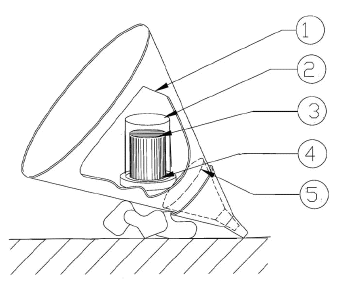 Its main components, as indicated in the diagram are: (1) a pliable,
aluminum-coated plastic reflector; (3) an aluminum beverage can with lid,
painted black (the "pot”); (2) a glass light fixture or jam jar placed over the
can (the "greenhouse”); (4) a support disk; and (5) two funnels sandwiching the
reflector. He uses this cooker for teaching solar cooking in remote areas.
Its main components, as indicated in the diagram are: (1) a pliable,
aluminum-coated plastic reflector; (3) an aluminum beverage can with lid,
painted black (the "pot”); (2) a glass light fixture or jam jar placed over the
can (the "greenhouse”); (4) a support disk; and (5) two funnels sandwiching the
reflector. He uses this cooker for teaching solar cooking in remote areas.
Another is the collapsible parabolic cooker he developed for use by trekking groups to promote ecotourism and minimize environmental deterioration. This cooker was initially designed for use during a unique Mount Everest cleanup expedition held in 2000.
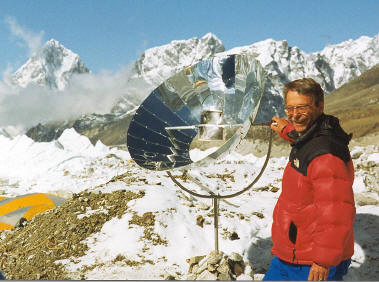 Of the Everest trip Allart says,
"Towards the middle of our trek we planned
to meet up with the [expedition] on the Everest Base Camp (B.C.) glacier. … We
would set up and leave the "Everest” cooker at B.C. for the expeditions’ use the
next two months during which time they would summit Everest and clear the
mountain of 600+ discarded oxygen bottles and other trash left by previous
expeditions over the past 50 years. This would provide exposure and public
relations for solar cooking with a chance that solar would be featured on film
shot by the film crews of the numerous (25!) expeditions. … The collapsible
cooker is optimized for high performance cooking speed and portability. It
weighs less than 4 kilograms (9 pounds) including the pot. The reflector
sections attach easily into a 1-meter (39-inch) parabolic reflector. Reflector
and aluminum tubing frame disassemble quickly for easy carrying. Our plan worked
out great. We unpacked the parabolic cooker, assembled the reflector and frame
and installed it on a small mound on the glacier. The next morning at 7:45 a.m.,
as soon as the sun came up over the mountains, I boiled Everest's first
solar-oven prepared water. Two liters of 0° C (32° F) water with clumps of ice
floating on top, under subfreezing temperatures and windy conditions, boiled in
20 minutes. I was very happy with the performance that early in the day and the
season, even realizing that at 5365 meters (17,600 feet) altitude the boiling
point is about 18° C (33° F) lower than at sea level. … We said our farewells,
leaving the cooker for use by base camp manager Doug Marsh and kitchen crews
during the next two months. Later we heard that in addition to pasteurizing and
boiling drinking water, the parabolic cooker was very popular to prepare hot
shower water!”
Of the Everest trip Allart says,
"Towards the middle of our trek we planned
to meet up with the [expedition] on the Everest Base Camp (B.C.) glacier. … We
would set up and leave the "Everest” cooker at B.C. for the expeditions’ use the
next two months during which time they would summit Everest and clear the
mountain of 600+ discarded oxygen bottles and other trash left by previous
expeditions over the past 50 years. This would provide exposure and public
relations for solar cooking with a chance that solar would be featured on film
shot by the film crews of the numerous (25!) expeditions. … The collapsible
cooker is optimized for high performance cooking speed and portability. It
weighs less than 4 kilograms (9 pounds) including the pot. The reflector
sections attach easily into a 1-meter (39-inch) parabolic reflector. Reflector
and aluminum tubing frame disassemble quickly for easy carrying. Our plan worked
out great. We unpacked the parabolic cooker, assembled the reflector and frame
and installed it on a small mound on the glacier. The next morning at 7:45 a.m.,
as soon as the sun came up over the mountains, I boiled Everest's first
solar-oven prepared water. Two liters of 0° C (32° F) water with clumps of ice
floating on top, under subfreezing temperatures and windy conditions, boiled in
20 minutes. I was very happy with the performance that early in the day and the
season, even realizing that at 5365 meters (17,600 feet) altitude the boiling
point is about 18° C (33° F) lower than at sea level. … We said our farewells,
leaving the cooker for use by base camp manager Doug Marsh and kitchen crews
during the next two months. Later we heard that in addition to pasteurizing and
boiling drinking water, the parabolic cooker was very popular to prepare hot
shower water!”
 According to Allart, continuous follow-up is of utmost importance to the
successful spread of solar cooking. In recent years, much of his communication
with Nepal has been via the Internet, but he still visits Nepal for a full two
to three months each year to monitor progress and fine tune projects. He visits
organizations that he worked with in the past as well as new ones. Ideas are
exchanged, issues discussed, new initiatives and projects worked on, and
lectures given. Here are report excerpts from a 2000 trip with his wife, Ineke:
According to Allart, continuous follow-up is of utmost importance to the
successful spread of solar cooking. In recent years, much of his communication
with Nepal has been via the Internet, but he still visits Nepal for a full two
to three months each year to monitor progress and fine tune projects. He visits
organizations that he worked with in the past as well as new ones. Ideas are
exchanged, issues discussed, new initiatives and projects worked on, and
lectures given. Here are report excerpts from a 2000 trip with his wife, Ineke:
- "During our trek we demonstrated and promoted solar cooking with my small roll-up backpack cooker. … At the Tyangboche Monastery I was lucky enough to spend a few hours with the Rimpoche (head Lama), the spiritual leader of the area. He expressed considerable interest in solar technologies of cooking, water pasteurization, space heating, drying (for herbs), and greenhouses. This would fit right in with his plans to build a small ecological demonstration center. He promised to buy one SK-14 parabolic cooker and buy more cookers if his people liked it. His blessings on solar would greatly help convince the Buddhist population of this region.
-
 We brought UV-resistant plastic to our friends of the
Sherpa Cultural Centre in Namche Bazar, to repair their solar water heater and
to construct greenhouses. At the high altitude medical hospital of Kunde we gave
[SCI's] CooKit as a wedding present to great friends of ours, Jim and Rachel
Litch. They have been volunteer doctors here for a few years.
We brought UV-resistant plastic to our friends of the
Sherpa Cultural Centre in Namche Bazar, to repair their solar water heater and
to construct greenhouses. At the high altitude medical hospital of Kunde we gave
[SCI's] CooKit as a wedding present to great friends of ours, Jim and Rachel
Litch. They have been volunteer doctors here for a few years. - At another health post in Pheriche I was glad to see that the solar cooker I had promoted last year is now being used every sunny day. It is important for the local population to know that individuals with high stature such as doctors are solar cooks.
- The high point of the trek actually occurred at lower altitudes … in the stretched-out village of Bhandar. We noticed a number of SK-14s there. So we decided to stay at a lodge because of its SK-14 cooker in the yard. According to the lodge keeper about 35 cookers were in use in this village of 400 families. Almost 9 percent! This would be an excellent place for CRT to promote even more solar cooking, drying, and photovoltaics, thus creating a "solar village”. (Update: the total has increased to 51 cookers, or 13 percent.)
-
 The next three
weeks I spent in the Kathmandu area, visiting all the organizations I dealt with
in the past, as well as new ones. CRT is still the main NGO that disseminates
solar cooking, drying, and water pasteurization. The
Vajra Foundation of my
Dutch friend Maarten Olthoff is very successful in the Bhutanese refugee camps
in eastern Nepal, where box cookers and SK-14 cookers are being produced.
The next three
weeks I spent in the Kathmandu area, visiting all the organizations I dealt with
in the past, as well as new ones. CRT is still the main NGO that disseminates
solar cooking, drying, and water pasteurization. The
Vajra Foundation of my
Dutch friend Maarten Olthoff is very successful in the Bhutanese refugee camps
in eastern Nepal, where box cookers and SK-14 cookers are being produced. - At the Biogas Support Program (BSP) the program manager was willing to fund two conferences including travel costs for biogas plant farmers from all over Nepal to investigate their interest in solar cooking. If the biogas community was interested, BSP could put all the power of its infrastructure into promoting solar with CRT as the technology provider.
- The Kathmandu Environmental Education Project (KEEP) was very interested in how solar can play an important role in responsible ecotourism. They enthusiastically accepted my SCI material and other reference papers for their library.
- Trekking Agencies Association Nepal (TAAN) and the Department of Tourism saw the real advantage of solar water pasteurization and portable solar cookers. They would like me to conduct training when I come back next year. They will investigate solar for potential new programs in the next planning cycle. (Update: in 2001 the Department of Tourism sponsored my presentation and demonstration "Solar Technologies for Better Environment and Health”, which was recorded on video. Nepal TV would do a program on this event.)
- I started a solar cooking program with Nepal Foster Mate (NFM) by donating two wooden box cookers, SCI manuals and conducting a workshop. NFM builds elementary schools in poor areas where the government does not provide any. Passive solar will be put in the curriculum.
- Working with the Nepal Liver Foundation (NLF) over the years has resulted in prototypes of small solar water pasteurizers to combat Hepatitis E. (Update: in 2001 we developed a 3-liter commercial version made out of a fiberglass shell and copper tank.) Outbreaks during the monsoon season cause 25 percent of pregnant women with this disease to die. I helped with the formation of a new NGO called PECON which disseminates all solar technologies of cooking, drying, water and space heating, and photovoltaics. (Update: during my 2001 stay, PECON established itself as an enthusiastic "champion” organization, producing very nice dryers and cookers. Their carpenters were fed solar food in the mornings and afternoons from the cookers they made.) An aluminum spinning workshop in Patan manufactured cooking sets for my backpack cooker. … Negotiations have started for the "Everest” cooker to be manufactured by Sunworks, a local solar water heater company, and PECON.”
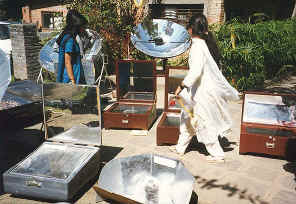 Much has been accomplished during Allart’s nine years of promotion in Nepal.
Awareness of solar cooking has been raised significantly. The number of solar
cookers has grown from two to over 3000 since the start of the program in 1992.
A reasonable infrastructure has been built. A number of organizations have
adopted solar cooking, drying, and water testing/pasteurization into their
programs, actively promote it, and give workshops. Small-scale manufacturing is
taking place in the Kathmandu valley as well as the Bhutanese refugee camps in
eastern Nepal. A number of schools, colleges and universities teach solar and
provide hands-on workshops. Nepal television has featured solar cooking as part
of a science program series. In remote regions and on trekking routes you now
encounter solar cookers, solar showers (for tourists) and sunrooms. The
government even started a 50 percent subsidy program for solar cookers and
dryers in 1998. Allart cautions, however, that the "challenges are still
enormous and so much more needs to be done.”
Much has been accomplished during Allart’s nine years of promotion in Nepal.
Awareness of solar cooking has been raised significantly. The number of solar
cookers has grown from two to over 3000 since the start of the program in 1992.
A reasonable infrastructure has been built. A number of organizations have
adopted solar cooking, drying, and water testing/pasteurization into their
programs, actively promote it, and give workshops. Small-scale manufacturing is
taking place in the Kathmandu valley as well as the Bhutanese refugee camps in
eastern Nepal. A number of schools, colleges and universities teach solar and
provide hands-on workshops. Nepal television has featured solar cooking as part
of a science program series. In remote regions and on trekking routes you now
encounter solar cookers, solar showers (for tourists) and sunrooms. The
government even started a 50 percent subsidy program for solar cookers and
dryers in 1998. Allart cautions, however, that the "challenges are still
enormous and so much more needs to be done.”
In addition to his work in Nepal, Allart has begun to spread solar cooking in Mongolia, Peru and Bolivia.
Contact: Allart Ligtenberg, Friendly Appropriate Solar Technologies (FAST), 800 Loyola Drive, Los Altos, California, 94024, USA. Tel/fax: (650) 948-8294, e-mail: aligtenber@aol.com, web: www.bali-i.com/fast-solar
Turkey Project off to Good Start
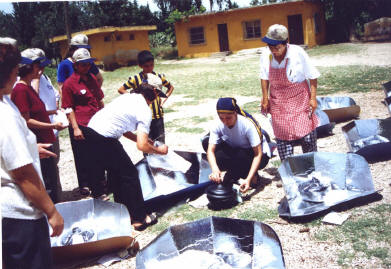 If all goes according to the plan laid out by Mr. Abdullah S. Paksoy,
thousands of Turkish families will have the equipment and knowledge to solar
cook within a period of just a few years.
If all goes according to the plan laid out by Mr. Abdullah S. Paksoy,
thousands of Turkish families will have the equipment and knowledge to solar
cook within a period of just a few years.
Mr. Paksoy has spent years preparing for his term as president of Seyhan Rotary Club of Adana, Turkey, and the solar cooking project he would orchestrate. Mr. Paksoy first contacted Solar Cookers International (SCI) in 1999 regarding his plans to spread solar cooking in Turkey. Over the next 15 months, he consulted often with SCI on topics such as specifications for plastic insulating bags, sources for pre-foiled cardboard for mass producing CooKits, ideas for creating public awareness, and project scope. During this time he received many of SCI’s instructional booklets, some of which were later translated into Turkish. Through networking, SCI helped the Adana Rotarians find multiple North American Rotary clubs willing to offer support. California Rotarian Wilfred Pimentel and his wife, Marie, who helped launch Rotary solar cooker projects in five other countries, contributed their experienced wisdom. SCI directed Mr. Paksoy to Solar Household Energy, Inc. (SHE), which sent Dr. Barbara Knudson (an SCI volunteer and board member) to train solar cooking teachers in Turkey.
 According to Dr. Knudson,
"Turkey has substantial industrial potential, a
solid agricultural base which feeds the nation and exports delicacies, a growing
middle class — in short, most of what is needed to make the leap to [a]
fully-developed country.” However, the economy is shaky, with high inflation and
unemployment nearing 20 percent. This — coupled with the fact that the price of
butane, a common cooking fuel in Turkey, has had a six-fold increase in three
years — was a primary factor in the desire to spread solar cooking in Turkey.
According to Dr. Knudson,
"Turkey has substantial industrial potential, a
solid agricultural base which feeds the nation and exports delicacies, a growing
middle class — in short, most of what is needed to make the leap to [a]
fully-developed country.” However, the economy is shaky, with high inflation and
unemployment nearing 20 percent. This — coupled with the fact that the price of
butane, a common cooking fuel in Turkey, has had a six-fold increase in three
years — was a primary factor in the desire to spread solar cooking in Turkey.
Mr. Paksoy has done extensive planning in hopes of conducting a successful, sustainable project. Says Dr. Knudson, "He did everything correctly. … He lined up experienced assistance in the design of solar projects by consulting widely with organizations. … He obtained [pledges] of financial assistance from a number of Rotary clubs in the United States, Canada, and the United Kingdom, putting him in good position for substantial matching funds to keep the project afloat for several years. He looked for and found local manufacturers for the CooKit, plastic bags, inexpensive aluminum pans, etc.”
In order to receive the pledged Rotary funds (US $22,500), as well as a Rotary International Matching Grant, the project proposal and budget must be approved by Rotary International. In preparation of this final project proposal, a pilot project was conducted in May, 2001, in Misis, a small town 20 miles east of Adana.
Misis (also known as Yakapinar) is an agricultural community of about 5,000 inhabitants. It is surrounded by fertile plains which have traditionally produced food crops but increasingly produce export crops like citrus fruits and artichokes. The town's elementary school served as home base for the pilot project.
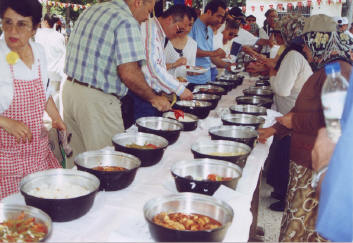 The Pimentels and Dr. Knudson arrived in early May — to two weeks of rain.
During that time, meetings were held with 11 future trainers and plans were
solidified. When the sun finally appeared, the future trainers brought food from
their homes to be cooked. Every dish was a success! "By this time, the
enthusiasm was generally very high,” says Dr. Knudson. "On this day, the cooks
purchased their own cookers for home use, going proudly home with the CooKit
under one arm and a well-cooked dish for their family under the other.” Over the
next ten days, other groups of future trainers were trained and follow-up visits
made. During these visits, questions were asked of the new solar cooks, and
recommendations were made. "We made a few suggestions as to the placement of the
cooker to get maximum sun exposure and shorten cooking times,” writes Mrs.
Pimentel. "We were warmly welcomed into their homes and could not leave until we
… tasted their solar-cooked food or cakes they had baked. … We tasted sarma,
dolma, bulgur with chickpeas or lentils or tomatoes and onions … stuffed
eggplant or peppers and other mixed veggie dishes! They were happy with their
results and we with our taste testing. They have been cooking other dishes every
day.” In total, over 100 new solar cooks received supplies and training.
The Pimentels and Dr. Knudson arrived in early May — to two weeks of rain.
During that time, meetings were held with 11 future trainers and plans were
solidified. When the sun finally appeared, the future trainers brought food from
their homes to be cooked. Every dish was a success! "By this time, the
enthusiasm was generally very high,” says Dr. Knudson. "On this day, the cooks
purchased their own cookers for home use, going proudly home with the CooKit
under one arm and a well-cooked dish for their family under the other.” Over the
next ten days, other groups of future trainers were trained and follow-up visits
made. During these visits, questions were asked of the new solar cooks, and
recommendations were made. "We made a few suggestions as to the placement of the
cooker to get maximum sun exposure and shorten cooking times,” writes Mrs.
Pimentel. "We were warmly welcomed into their homes and could not leave until we
… tasted their solar-cooked food or cakes they had baked. … We tasted sarma,
dolma, bulgur with chickpeas or lentils or tomatoes and onions … stuffed
eggplant or peppers and other mixed veggie dishes! They were happy with their
results and we with our taste testing. They have been cooking other dishes every
day.” In total, over 100 new solar cooks received supplies and training.
The culmination of the training occurred on Saturday, May 26th, when 32 CooKits were used to prepare a solar-cooked feast for 125 Rotarians, media members and curious Misis citizens.
Mrs. Pimentel’s account of the event: "By noontime, the first pots were opened one at a time by the proud trainers and the hot steaming food was placed on the serving tables buffet-style. Everyone crowded around to see what had been cooked, and when all the pots were on the serving table the feast began. It was a huge success and not a spoonful of food was left! Even the skeptics had smiles of approval. The happy, proud trainers were given certificates, … praise and applause for all their efforts. From this event have come many requests for solar cooker workshops in the targeted region. The trainers are excited and ready to serve!”
Project leaders hope to reach 15,000 families over four years. Three specific groups of people will be served — small town residents; rural populations, primarily living on large agricultural estates; and the extremely poor migrant workers who mostly live in eastern Turkey and travel to fertile areas during the summer months to work.
Mr. Paksoy is extremely appreciative of all the support his Rotary club has received thus far. In a letter to SCI he writes, "Your help is really very valuable to us — without that — the project would not have come this far. Please forgive me if I neglect to thank you enough.”
Contact: Abdullah S. Paksoy, Seyhan Rotary Club of Adana, Kurtulus Mah., Sinasi Ef. Cad. No. 9/1 - 01120, Adana, Turkey. Tel: +90 322 454 07 33, fax: +90 322 458 07 50, e-mail: aspaksoy@ixir.com or aspaksoy@turk.net; Barbara Knudson, 1823 SE Franklin Avenue, Minneapolis, Minnesota, USA. Tel: 612-378-2634, fax: 623-338-5092, e-mail: bknudson@waldenu.edu; Wilfred Pimentel, 1035 East Cambridge, Fresno, California 93704, USA. Tel: 559-222-4193, e-mail: solarcook@att.net
![]() You
can listen an
interview with Barbara Knudson discussing this project.
You
can listen an
interview with Barbara Knudson discussing this project.
by Terry Grumley
SCI Executive Director
In the April 2001 Solar Cooker Review I highlighted key SCI accomplishments over the past 13 years and noted some of our ideas about the future direction of the organization. We have incorporated those ideas within a strategic plan that provides a map of how to extend our humanitarian reach and effectiveness over the next three years. The plan stresses improved capacity as a learning organization and focuses on six goal areas: project management, technical support, information exchange, research, education and advocacy.
Project Management
An increase in our capacity to plan, monitor and evaluate will heighten our effectiveness in implementing projects, in documenting lessons learned, and in demonstrating the value of our projects to donors, grant makers and stakeholders. A project implementation guide will be produced assuring that new projects — and, to the extent possible, old projects — serve as examples for future replication.
As we turn over projects in Aisha and Kakuma refugee camps to local management, we will initiate a new project in a non-refugee camp setting in Kenya.
The current East Africa SCI office will be expanded to a full resource center to better meet the needs of the region and provide addition support toward the achievement of SCI’s goals.
A stronger emphasis on solar water pasteurization will be incorporated into SCI projects. In addition, we will continue to use complementary, fuel-saving technologies like the "fire-less cooker.”
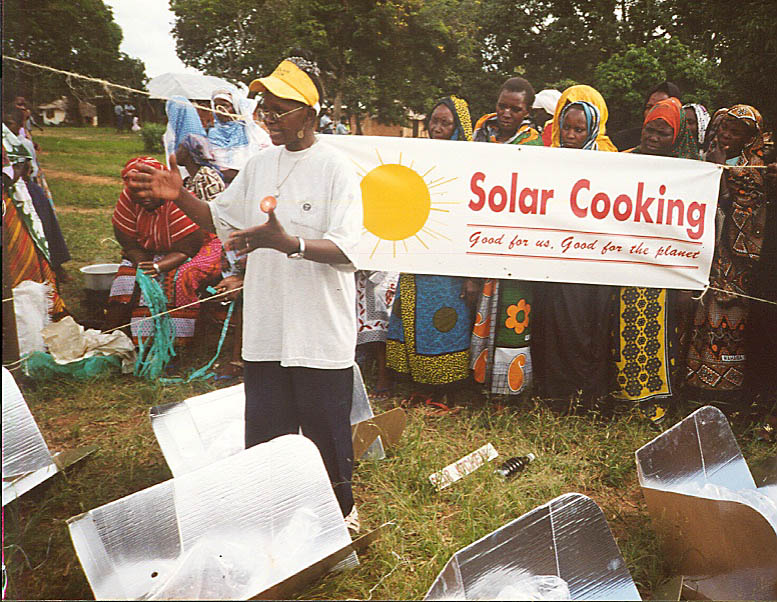
Faustine Odaba, SCI Field Assistant,
explains solar cooking to
residents
of Kwale, Kenya
Technical Support
Services will be designed to meet the solar cooking/pasteurization needs of varied organizations — from small, community-based grassroots organizations to large, international non-governmental organizations. This tailored support will assist dozens of organizations in the next three years.
A body of materials to include guidelines, tools and procedures will be created to support a cadre of SCI staff who are qualified to conduct needs assessments, project planning, training, monitoring and evaluation activities.
In addition to paid staff, SCI will maintain contact with a network of volunteers and solar cooker specialists who provide services, in accord with SCI guidelines, to organizations deemed eligible for support through an assessment process.
The use of standardized formats to monitor and evaluate results of SCI-supported projects will allow for valuable information exchange between implementing organizations.
Information Exchange
SCI will bolster its role as the world leader in information exchange on solar cooking and solar water pasteurization. Through periodic surveys, standardized reporting formats, expanded website capability, and an updated hard copy filing system, SCI will encourage the solar cooking community to use SCI as a resource for shared information. SCI will promote a continuity of dialogue on relevant issues through its newsletter, website discussions and participation in — and support of — international conferences.
Research
SCI will support advancements in technologies, methodologies and processes within the field through an SCI-facilitated research program. Research priorities will be determined with input from the international solar cooking/pasteurization community, and a network of researchers organized to plan the collaborative efforts and report on progress.
Education
SCI will continue to provide education materials for solar cooks and consumers. Additionally, we will work to better educate our supporters and donors about key issues pertaining to solar cooking and SCI’s programs and services.
We will work with educators and community leaders to develop education materials for school children to raise awareness of environmental issues and reinforce the positive impact of solar cooking/pasteurization projects. We will also improve communication with solar cooker manufacturers in order to share lessons learned in the field that would enhance their products and services.
Advocacy
With assistance from others within the solar cooking/pasteurization community, SCI will develop and initiate a plan that results in increased support and sponsorship of projects by governments and large international agencies.
To achieve these goals we will need to steadily increase our financial base, add qualified staff, and upgrade our management systems.
For starters, we recently received a two-year grant that enabled us to hire four new staff members. In the East Africa Region, Solomon Okumu Ndiao has joined us as Program Coordinator to work closely with Margaret Owino, our Regional Representative. He will be based in Nairobi. Virginia Ruguru Njoroge is our Project Coordinator for the Kakuma Refugee Camp Solar Cooking Project. In Sacramento, Pascale Dennery has joined as the SCI Program Manager. She will provide support to our field programs and secure a wider base of grant support for those projects. Bernadette Lenc has accepted the Office Support Specialist position and will provide assistance to our Office Manager and Resource Coordinator.
As you can see, we have identified a challenging set of goals for the next three years. We cannot, of course, work on all of these at the same time. But through a sequencing of efforts, starting with the project management and technical support areas and continuing through the other four, we will steadily progress towards the achievement of all our goals.
Solar Relief for Madagascar Cooks
by Alice M. Hoenecke
 In June of 1999, a solar cooking project was begun in Madagascar by
Californian Alice Hoenecke, sociologist Randriananantsoa Agnes, and
nutritionist/health worker Sosana Suzanne. Mrs. Agnes and Miss Sosana are
workers with SALFA, the medical arm of the
Malagasy Lutheran Church. SALFA is
composed of some 25 hospitals and clinics spread throughout the country. It is
through the encouragement and support of Dr. and Mrs. Stanley Quanbeck, lifelong
medical missionaries in Madagascar, that the project was initiated and continues
to expand. The project is also associated with Pathologists Overseas, an NGO
involved in a medical project with SALFA.
In June of 1999, a solar cooking project was begun in Madagascar by
Californian Alice Hoenecke, sociologist Randriananantsoa Agnes, and
nutritionist/health worker Sosana Suzanne. Mrs. Agnes and Miss Sosana are
workers with SALFA, the medical arm of the
Malagasy Lutheran Church. SALFA is
composed of some 25 hospitals and clinics spread throughout the country. It is
through the encouragement and support of Dr. and Mrs. Stanley Quanbeck, lifelong
medical missionaries in Madagascar, that the project was initiated and continues
to expand. The project is also associated with Pathologists Overseas, an NGO
involved in a medical project with SALFA.
The initial solar cooking workshops were conducted in the village of Ejeda, located in the semiarid region of southwestern Madagascar, to two groups of women totaling 29 participants. They were hospital workers and members of a church women’s organization who wanted to learn to cook and to teach solar cooking.
Solar Cookers International (SCI) and Barby Pulliam, an international training facilitator (and SCI board member), provided the valuable information, teaching materials, and consultation for the startup of the project.
Despite the fact that transportation and communication to Ejeda (only by radio) and the surrounding villages is difficult, the area was chosen because of the dire need for an alternative way to cook. Fuelwood is scarce, making the purchase of charcoal necessary. Charcoal is becoming increasingly expensive and is not always available.
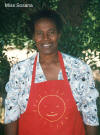 Miss Sosana — a community health worker for over 20 years — directs the
project from her home in Ejeda, traveling to the outlying villages and
transporting the solar cooker supplies by her own oxcart. Presently she has 15
trainers who, along with the support of village leaders, currently teach in 11
villages near Ejeda. In several villages, primary health care clinics are
teaching centers for spreading solar cooking. Offering and teaching solar
cooking technology in conjunction with instruction in better nutrition and
health practices promotes and enhances the health service work. Presently there
are 561 reported users and many others (reported estimate of more than 500) in
scattered rural villages who are requesting that Sosana bring solar cooking
technology to them. Travel and transportation of goods is slow and difficult.
Miss Sosana — a community health worker for over 20 years — directs the
project from her home in Ejeda, traveling to the outlying villages and
transporting the solar cooker supplies by her own oxcart. Presently she has 15
trainers who, along with the support of village leaders, currently teach in 11
villages near Ejeda. In several villages, primary health care clinics are
teaching centers for spreading solar cooking. Offering and teaching solar
cooking technology in conjunction with instruction in better nutrition and
health practices promotes and enhances the health service work. Presently there
are 561 reported users and many others (reported estimate of more than 500) in
scattered rural villages who are requesting that Sosana bring solar cooking
technology to them. Travel and transportation of goods is slow and difficult.
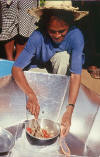 Except for the aluminum foil, which is shipped from the United States, all of
the required materials are available for purchase and shipped to Ejeda from
Antananarivo, the capital city. The cost of materials for one panel cooker is
approximately US $2.50, and $2.00 has been the affordable purchase price for
some users. Others, not able to pay, are provided a cooker as they are the most
needy of saving fuel costs. The quality of the cardboard and plastic bags has
been fairly good, but a number of women, having to cook for very large families,
have the need for larger pots and CooKits. Many cooks also wish to have a
cooking pot used only for solar cooking. The soot-blackened pot, which is used
for both fire cooking and solar cooking, soils the plastic bag, and with the
required repeated washing of the dual-use, black-painted pot, the black paint is
scrubbed off. In the crowded one-room hut homes, there is also a need for a very
large plastic bag in which to store and protect the partially folded panel
cooker.
Except for the aluminum foil, which is shipped from the United States, all of
the required materials are available for purchase and shipped to Ejeda from
Antananarivo, the capital city. The cost of materials for one panel cooker is
approximately US $2.50, and $2.00 has been the affordable purchase price for
some users. Others, not able to pay, are provided a cooker as they are the most
needy of saving fuel costs. The quality of the cardboard and plastic bags has
been fairly good, but a number of women, having to cook for very large families,
have the need for larger pots and CooKits. Many cooks also wish to have a
cooking pot used only for solar cooking. The soot-blackened pot, which is used
for both fire cooking and solar cooking, soils the plastic bag, and with the
required repeated washing of the dual-use, black-painted pot, the black paint is
scrubbed off. In the crowded one-room hut homes, there is also a need for a very
large plastic bag in which to store and protect the partially folded panel
cooker.
Although the project has been underway for two years, for the first six to eight months of the project Sosana was severely ill. However, with her present recovery and returned health, it is expected that the spread of solar cooking will continually increase. It has been an encouraging and rewarding project because the women are very eager to solar cook for its multiple benefits. In many instances, the users have reportedly saved from one-third to one-half of their fuel costs.
Contact: Alice M. Hoenecke, 12902 Via Grimaldi, Del Mar, California 92014, USA. Tel: (858) 755-1787, fax: (858) 755-1570, e-mail: ambhrh1@aol.com; or Andriamanantsoa Agnes, Andahalo BP 4402, Antananarivo 101, Madagascar. E-mail: salfa@dts.mg; Solar box cooker plans in Malagasy are here.
Youth-Led Solar Cooker Project in Malawi
by David Baines
 Peace Child International is a nonprofit organization promoting youth
empowerment and education for sustainable development. Its most recent program,
Be The Change! (BTC), supports young people in the implementation of
sustainable, youth-led community action projects. Through the BTC program, young
people 12 to 25 years of age — in partnerships with adults — learn the process
of sustainable development by prioritizing local needs and identifying local
solutions to meet those needs.
Peace Child International is a nonprofit organization promoting youth
empowerment and education for sustainable development. Its most recent program,
Be The Change! (BTC), supports young people in the implementation of
sustainable, youth-led community action projects. Through the BTC program, young
people 12 to 25 years of age — in partnerships with adults — learn the process
of sustainable development by prioritizing local needs and identifying local
solutions to meet those needs.
To illustrate the strength of the Be The Change! program, here is a case study example of a successful youth-action proposal from Malawi. It involves the local development and distribution of solar box cookers.
19-year-old George Manyenje submitted a BTC proposal along with the 15 members of the SOS Environmental Youth Club of an SOS village in the Lilongwe district of Malawi. George’s BTC project proposes to develop a solar cooker which is made from local materials, which meets local needs and is sold at an affordable price. Prototypes of the locally-appropriate solar cooker will be assembled at the SOS village and then used as part of educational workshops in local villages. Both the planning and implementation of the project involve young people from local areas working in partnership with adults. This proposal was budgeted at US $1,100.
To date the SOS Environmental Club has placed 50 solar cookers in 9 of the 26 districts in Malawi. Support had been forthcoming from organizations in Germany and Austria. These solar cookers were distributed free of charge as part of a one-year trial period in order to identify the potential of this technology for Malawi. The results and feedback of this outreach will be incorporated into George’s solar cooker project. The major challenge of finding locally available cheap reflective material might be met by Universal Industries. This major food supplier in Malawi uses strong shiny paper for potato crisp packets. The SOS village is exploring these possibilities.
Contact: George Manyenje, SOS Hermann Gmeiner Secondary School, P.O. Box 20522, Kawale, Lilongwe 2, Malawi. Tel: 00 265 766 667, fax: 00 265 751 298, email: sosmalawi@malawi.net; for information about the Be The Change! program or to submit a project proposal, contact: Peace Child International, The White House, The High Street, Buntingford, Hertfordshire, SG9 9AH, United Kingdom. Tel: 00 44 (0) 1763 274 459, fax: 00 44 (0) 1763 274 460, email: contact@peacechild.org, web: www.peacechild.org
CASEP Holds Seventh Regional Meeting
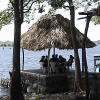 The Central American Solar Energy Project (CASEP) held their seventh regional
meeting July 17-22 near Granada, Nicaragua. Traveling from Guatemala, Honduras,
Costa Rica, the U.S. and from around Nicaragua, 85 participants gathered to
understand the reality of the CASEP program, share ideas, and generate plans for
the future. While the programs in each country share the same basic model of
solar cooking and the same process of using solar cooking as a tool for women’s
advancement and community organizing, the conference highlighted the unique
innovations of each country. Participants discussed the specifics of how they
realize the promotion of solar cookers from the initial organizing stages,
through construction, follow-up and the formation of autonomous local
organizations. Also discussed were the related projects that have grown out of
the solar cooking project including an infant nutrition program in Honduras and
various permaculture techniques used in Guatemala. The meeting included a
participative workshop on gender within the project and within the families and
communities of the women involved in promoting solar cooking. Having constructed
hundreds of solar cookers across Central America, CASEP has grown into a
regional, multifaceted project while encouraging the creative growth of each
national initiative.
The Central American Solar Energy Project (CASEP) held their seventh regional
meeting July 17-22 near Granada, Nicaragua. Traveling from Guatemala, Honduras,
Costa Rica, the U.S. and from around Nicaragua, 85 participants gathered to
understand the reality of the CASEP program, share ideas, and generate plans for
the future. While the programs in each country share the same basic model of
solar cooking and the same process of using solar cooking as a tool for women’s
advancement and community organizing, the conference highlighted the unique
innovations of each country. Participants discussed the specifics of how they
realize the promotion of solar cookers from the initial organizing stages,
through construction, follow-up and the formation of autonomous local
organizations. Also discussed were the related projects that have grown out of
the solar cooking project including an infant nutrition program in Honduras and
various permaculture techniques used in Guatemala. The meeting included a
participative workshop on gender within the project and within the families and
communities of the women involved in promoting solar cooking. Having constructed
hundreds of solar cookers across Central America, CASEP has grown into a
regional, multifaceted project while encouraging the creative growth of each
national initiative.
Contact: CASEP, 10718 Scott Drive, Fairfax, Virginia 22030, USA. E-mail: casep@erols.com, web: http://mason.gmu.edu/~wlankfor/index.htm; Anna Garwood, e-mail: proceso@rlc.net
Good Summer for Media Coverage
Major U.S. media coverage of solar cooking advocates and Solar Cookers International (SCI) increased this past summer. Lengthy articles appeared in the Sacramento Bee (June 13 and August 25), the Washington Post (August 29), and the Los Angeles Times (September 5). Two major west coast radio stations, KGO in San Francisco and KPFA in Berkeley, California, broadcast programs focused on solar cooking and interviews with an SCI board member (June 17 and August 21, respectively). There were also many smaller publications that published solar cooking articles.
We do our best to keep track of all solar cooking news, regardless of format, and we share some of those stories through the Solar Cooker Review and our website. You can help us by sending in articles that you see, or informing us of radio/television broadcasts that occur. Many of our supporters have sent in articles and news over the years, and we very much appreciate it. Please keep it up! We know that potential solar cooking enthusiasts are out there, just waiting to read, hear, or see a great solar cooking story — and ultimately, become supporters of this environmental-friendly, humanitarian technology.
Villagers in Sri Lanka Learn to Solar Cook
 Sri Lanka is in many ways ripe for solar cooking. Much of the region receives
a good amount of annual sunlight. A large percentage of the population live in
rural areas and use ever-diminishing supplies of wood for cooking fuel. Forest
cover has dropped to 17 percent, from an estimated 84 percent of the island’s
land area in 1880. In urban areas, those who have access to electricity or gas
have found these fuels increasingly expensive since the deregulation of the
energy sector. Also, due in large part to a lengthy civil war, there are now
hundreds of thousands of refugees living in the northern and eastern parts of
Sri Lanka that have little income and limited access to cooking fuels.
Sri Lanka is in many ways ripe for solar cooking. Much of the region receives
a good amount of annual sunlight. A large percentage of the population live in
rural areas and use ever-diminishing supplies of wood for cooking fuel. Forest
cover has dropped to 17 percent, from an estimated 84 percent of the island’s
land area in 1880. In urban areas, those who have access to electricity or gas
have found these fuels increasingly expensive since the deregulation of the
energy sector. Also, due in large part to a lengthy civil war, there are now
hundreds of thousands of refugees living in the northern and eastern parts of
Sri Lanka that have little income and limited access to cooking fuels.
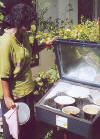 It is for these very reasons that Mr. E. Abeyrathne contacted Solar Cookers
International (SCI) in January 2000 asking for advice. He wanted to know how his
non-profit organization, EMACE, could best begin to teach the people of Sri
Lanka how to cook with the sun. After a few months of correspondence with SCI,
Mr. Abeyrathne used
SCI’s e-mail solar cooking discussion group to post a
request for an experienced solar cook to come to Sri Lanka to help EMACE begin a
project. It just so happened that two Canadians, Lee Sentes and Kathleen Manion,
were looking for such an opportunity. They had just returned home from working
on a small solar cooker feasibility project in Madagascar and had lots of
experience to share.
It is for these very reasons that Mr. E. Abeyrathne contacted Solar Cookers
International (SCI) in January 2000 asking for advice. He wanted to know how his
non-profit organization, EMACE, could best begin to teach the people of Sri
Lanka how to cook with the sun. After a few months of correspondence with SCI,
Mr. Abeyrathne used
SCI’s e-mail solar cooking discussion group to post a
request for an experienced solar cook to come to Sri Lanka to help EMACE begin a
project. It just so happened that two Canadians, Lee Sentes and Kathleen Manion,
were looking for such an opportunity. They had just returned home from working
on a small solar cooker feasibility project in Madagascar and had lots of
experience to share.
The Sri Lanka project commenced in December 2000 with the arrival of Lee and Kathy. The main focus of the project is to provide skills training to EMACE and to villagers in four districts around Sri Lanka: Anuradhapura, Kurunegala, Puttalam and Hambantota. The criteria used for village selection included amount of sunlight throughout the year, difficulty in acquiring fuelwood, levels of deforestation, and villager incomes. Workshops have been conducted in all of these areas, in which villagers, NGOs and community-based organisations (CBOs) have been given training on how to use, build and maintain solar box cookers. A couple of larger solar box cookers have been built to meet the needs of families living in refugee camps. These cookers can be used by multiple families simultaneously and could possibly be used as a solar bakery for community income generation. Public interest is quite high due to television, radio, and newspaper publicity. Says Mr. Abeyrathne, "The response itself has been overwhelming at times. Following a workshop in Hambantota, the CBO responsible for its organisation received over 300 letters of inquiry.” Furthermore, EMACE has, over the years, established relationships with a large number of NGOs, CBOs, and women’s groups throughout Sri Lanka, helping to further spread the word.
EMACE has found an excellent carpenter to build cookers, and hopes to create a manufacturing and distribution center for solar cookers and solar technology products in the capital city of Colombo. The proceeds from the sale of cookers (approximately US $20 each) and other products would be cycled back into the project, allowing it to possibly be sustained and hopefully expanded.
Like most projects, there have been challenges. Mr. Abeyrathne writes, "What has been discovered during the workshops has been a keen interest by participants and a desire to try the cooker at their own home. This interest means that the initial introduction of the cookers has been quite easy. What is far more difficult is convincing people to use the cooker as much as possible. Cooking time (using the box-style cookers that are easily constructed and promoted during the workshops) is greatly increased in the solar cookers. Therefore a meal that would take 30 minutes to prepare over an open fire, may take 1 to 2 hours in full sunlight. This necessitates a great change in how meals are prepared.”
Another challenge has been funding. Some funds have been provided by the Sri Lanken/Canadian High Commission Small Grants Program and by the Kitchener-Conestoga Rotary Club. Additional funds are needed, as are volunteers.
Nearly 50 solar cookers have been made and distributed to established village groups thus far. Because the cooker design is simple, it is more easily replicated in villages at a reasonable cost.
Contact: Mr. Abeyrathne, EMACE, 15 Mihiri Place, Asiri Uyana, Katubedda, Moratuwa 10400, Sri Lanka. Tel: 94-1-612837, fax: 94-1-610080, e-mail: emace@slt.lk; L. Sentes and K. Manion, 9 Senrab Street, Stepney Green, London E1 0QE, United Kingdom.
Note: the e-mail discussion group can be joined through the SCI website at solarcooking.org or by sending an e-mail to solarcooking-l-subscribe@igc.topica.com from your computer.
Solar Cookers International is making a world of difference. Your contribution will be gratefully received and used to strengthen the spread of this solar solution.
Please consider these giving options:
- SCI in your will
"I give and bequeath to Solar Cookers International of Sacramento, California $______ (or ______% of my estate) to be used for its humanitarian purposes.”
- Investing in SCI
If you have a choice between donating appreciated stock or cash to SCI, there are two tax advantages of donating stock. First, you receive an income tax charitable deduction for the full market value of the stock at the time it is donated. Second, you avoid paying any capital gains tax on the increase in value of the stock. You can invest in SCI and invest your cash in current stock. It’s a win-win situation!
- Spreading the word
Recruit potential members by asking interested friends, "Did you know that a forty dollar contribution to SCI provides cookers and cooking supplies for a refugee family?” or, "Did you know that twenty-five dollars provides food for two workshops lead by local refugee trainers?”
Contact Virginia Callaghan at (916) 455-4499 to discuss donations and stock transfers. Consult your financial planner for additional information. Thank you.
Community Solar Kitchens for Quake Victims in Kutch, India
The following is based on a report, by Dr. Girja Sharan, pertaining to the tragic earthquake that hit the Indian state of Gujarat on January 26, 2001. An estimated 30,000 people died in the quake, and upwards of 500,000 people left homeless.
"After seeing media reports of widespread destruction in Kutch, we decided to help by setting up community solar kitchens where needed. We selected box cookers for this purpose because these can be deployed instantly and because they offer flexibility in scale of operation — from single family to a large community. We took 16 cookers and necessary provisions with us. The idea was that this will enable women to save two to four hours a day which they can devote to care and repair. After loading the cookers [with food] they are not required to watch over the cookers.
"Our team reached Bhachau by 3:00 p.m. on January 31 [2001]. … [We] proceeded to select a place to start a 100-meal solar kitchen. Bhachau was overcrowded with help so we selected a village (Vijpasar) 20 kilometers away. … Structures have all been pulverized so thoroughly that if the rubbles were swept clean, it would be difficult to tell if a village ever stood there. This is 45 kilometers from the epicenter of the quake that may have been as high as 8.1 on the Richter scale.
"A site in an open field (20 foot x 20 foot) was marked and fenced that evening and kitchen set up by 10:00 a.m. next day. On suggestion from the women, we made khir, khichdi, and vegetable curry. … Food was ready by 1:00 p.m. Children were delighted to get khir. The solar intensity is high in this area and remains so through the year.
"After lunch, cookers were loaded again to [get] the dinner ready. We used 13 cookers in this village. We returned to the village the next day to see if they needed additional instructions. They did not and had begun using these on their own. Nearly 50 persons could eat here twice a day.
"While in Bhachau, I was approached by the head of Anand Kanika High School (in Gandhidham) where there are 700 students, to similarly set up a kitchen there. I used their cell-phone to ask the Khadi Village Industry (KVIC) in Ahmedabad to rush 18 more cookers to that school, which they did. I visited the school the next day and advised them on how to get going. About 60 persons can eat here, twice a day.
"At Bhachau a roadside first aid medical camp took one cooker to heat water to wash wounds. One cooker was given to Andhajan Mandal, which too was devastated. They need more.
"We camped for four days at a Temple Complex near Bhachau, cooked meals by portable stove at night and solar cooker during the day. The main temple and all other associated buildings had collapsed. We slept out in the open all these four days in sleeping bags.
"Our team consisted of, besides me, Dr. D.S. Parmar of our Institute and Mr. Dilsingar Singh of KVIC, Ahmedabad. Cookers were given to us for this purpose free by Gujarat Energy Development Agency, Baroda. Other expenses were met from a grant from Cummins (India) Foundation, Pune.”
Contact: Dr. Girja Sharan, Indian Institute of Management, Vastrapur, Ahmedabad - 380 015, India. Tel: 91-079-6407241, fax: 91-079-6427896.
This story received some coverage in the press Here are some articles:
- Solar cookers feeding survivors in Kutch
- IIM-AHD Professor hits upon a novel idea
On the evening of October 6, 2001, SCI board members, staff, volunteers, and friends gathered to honor five individuals who have contributed immensely to the success of Solar Cookers International and the worldwide spread of solar cooking.
At 6:00 pm., just as the sun was setting over the Sacramento skyline, we gathered at the top of one of city’s tallest buildings for the event dubbed "A toast at the top.” After enjoying hors d’oeuvres, drinks, and a beautiful reddish-orange sunset, we gathered for the ceremony.
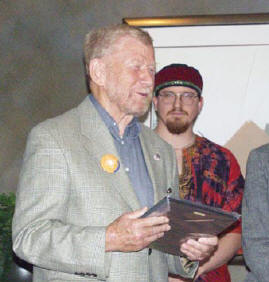 |
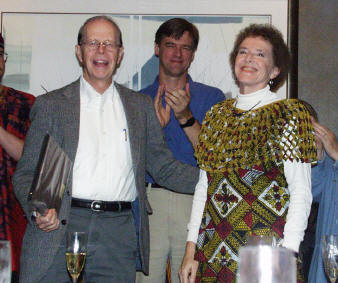 |
|
| John Collentine | Bob Metcalf and Bev Blum |
SCI board president Christopher Gronbeck began the ceremony with some inspiring words to help set the tone of the evening. He reminded us that we sometimes need to take a break from worrying about scarcity and concentrate on the abundances in our lives that are worth celebrating and sharing ? culture, art, wisdom, nature, and of course, sunlight.
Next, solar cooking pioneer and former board member Dr. Bob Metcalf presented SCI’s highest honor, the Order of Excellence award, to two extremely deserving individuals -- Bev Blum and John Collentine. Bev was honored for her years of dedicated service as executive director of SCI, as well as for her key role in founding the organization. John was honored for his years of outstanding volunteer efforts, particularly in the local Sacramento area, and for his willingness to step in as interim executive director after Bev’s retirement in 1999.
The Volunteer of the Year award went to Tom Sponheim for his role in creating and maintaining the Solar Cooking Archive (SCI’s website at solarcooking.org), which is by far the most comprehensive solar cooking website in existence.
The ceremony ended with the presentation of the new Partners award, designed to honor those who help SCI work with other organizations to further influence the spread of solar cooking worldwide. This year’s recipients, Rotarian Wilfred Pimentel and Girl Guide Barby Pulliam, have spent years working with SCI and their respective organizations to spread solar cooking in several countries.
Thanks to everyone who helped make this a special evening, especially the honorees that continue to inspire us every day.
Dedicated: SCI’s Faustine Odaba
 When Solar Cookers International (SCI) hired Faustine Odaba as a Field
Assistant in our East Africa office last year, she had already proven her mettle
time and time again. This, in brief, is the story of Faustine and solar cooking.
When Solar Cookers International (SCI) hired Faustine Odaba as a Field
Assistant in our East Africa office last year, she had already proven her mettle
time and time again. This, in brief, is the story of Faustine and solar cooking.
In the very early 1990s, Faustine was an active member and a leader of the Amagoro Housewives Group in the Busia District of western Kenya. The group soon met up with US Peace Corps volunteer Barbara Ross, who brought with her a wooden solar box cooker obtained from Trans World Radio (TWR).
The members of the group shared the cooker, and soon learned to be expert solar cooks. They quickly realized that one solar cooker was not enough and began searching for ways to acquire more, but were unable to afford the TWR cookers. When they heard of Solar Cookers International, they contacted us for information about making low cost solar box cookers from cardboard.
After receiving basic instructions from SCI, the group followed up with several more correspondences seeking additional tips, including how to test aluminized gift wrap, which was very easily available, as a substitute for aluminum foil. (Tip: heat a small sample of the gift wrap by conventional means or in an existing solar cooker. Many aluminized gift wraps will melt. Others will hold up fine in temperatures of 300° to 400° F (150° to 200° C).)
By 1992, Faustine and her colleagues were demonstrating solar cooking at fairs, agricultural shows, markets and even along roadsides. In 1993, Faustine explained to a reporter from the Kenya Times that, "after using it in our homes, we did not want to keep this information to ourselves.”
She also told the reporter that solar cookers work well for arrow root, sweet potatoes, githeri, and ugali from both cassava flour and from maize flour. The recipe she gave for ugali was "for every cup of unga, put two cups of cold water, stir it well, place it in the cooker and leave it for a while. After one and a half hours, it will be well cooked and hard. This cooker saves us time as well as having a smoke-free environment.” (Note: preferences for ugali’s texture apparently vary from region to region; not all people will necessarily enjoy Faustine’s ugali recipe.)
In 1994, Faustine and other members of the Amagoro Housewives attended the first Kenya-wide solar cooking conference. As the only seasoned Kenyan solar cooks in attendance, they were stars of the show, overwhelming the doubts of skeptics with their first-hand experience of solar cooking success.
When SCI launched its first field project in Kakuma refugee camp in 1995, Faustine was there, one of three volunteers who led the initial teaching program. Faustine was also a key volunteer when SCI launched its first project for settled communities in Zimbabwe in 1996.
Again, in 1997, Faustine was deeply involved with the launching of SCI’s project in Aisha, Ethiopia.
In about this same time period, Faustine began service as Field Supervisor for the Nairobi East "SOLACOOK” solar cooking program. She also continued to help out with SCI’s field projects. In 1999, she distinguished herself again while on a working trip to Kakuma by helping to convince a depressed refugee to not commit suicide.
Experience, commitment and great heart! SCI is indeed proud to have Faustine Odaba as a member of our stellar East Africa team!
Just wanted to tell you about my experience with your "CooKit” solar oven. I came to [the SCI] office several months ago because a church group had asked me to teach a class on summer cooking with energy savings and power outages in mind. I bought a CooKit, tried it, and included it as the centerpiece of my presentation. The women were so enthusiastic that the next month they had a workshop where, using my oven as a pattern, they made CooKits for about 15 women. Two more women, finding out about your organization and wanting to help, decided to purchase one from you instead. I have been experimenting with my CooKit and have found that I can adapt many slow-cooker or casserole recipes to it. And I love how I can put dinner together late morning, leave it out all day and when my family asks what’s for dinner, I just go out and get it!
— Linda Pullicar
Mary Ann continues to use her four solar ovens (three different styles). Beans, granola, and casseroles are regular items, but their greatest use is during fruit canning season. In two of the last three summers she solar canned 200 quarts of fruit sauce.
— Chuck Hoskings
Outstanding Volunteer and Teacher!
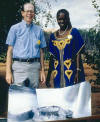 Volunteer extraordinaire and prior SCI board member Dr. Bob Metcalf was
selected as the 2000-2001 Outstanding Teacher in the College of Natural Sciences
and Mathematics at California State University in Sacramento, California. Award
criteria include teaching effectiveness and impact on the lives and careers of
students. Dr. Metcalf is well known for his work with solar cookers and solar
water pasteurization in many countries around the world, most recently in
Tanzania.
Volunteer extraordinaire and prior SCI board member Dr. Bob Metcalf was
selected as the 2000-2001 Outstanding Teacher in the College of Natural Sciences
and Mathematics at California State University in Sacramento, California. Award
criteria include teaching effectiveness and impact on the lives and careers of
students. Dr. Metcalf is well known for his work with solar cookers and solar
water pasteurization in many countries around the world, most recently in
Tanzania.
The following is based on an Ulrich Zimmermann letter to SCI concerning the recent travels of Mrs. Anne Kahn to Tibet. It is Mrs. Kahn’s impression that solar cooker usage is quite common in Tibet.
 "This journey she had undertaken together with two other women … in order to
visit Buddhist monasteries there. But to their own surprise they found … solar
stoves [used] to heat water for butter tea or other purposes. Even in the
[inexpensive] hotels run by Tibetans, where they stayed over night, solar stoves
were used to heat the water which every guest was handed over in a thermos
flask. Often the solar stoves of hotels were hidden in a back yard, but in one
case, at Latse, three solar stoves were placed directly beside the entrance.
"This journey she had undertaken together with two other women … in order to
visit Buddhist monasteries there. But to their own surprise they found … solar
stoves [used] to heat water for butter tea or other purposes. Even in the
[inexpensive] hotels run by Tibetans, where they stayed over night, solar stoves
were used to heat the water which every guest was handed over in a thermos
flask. Often the solar stoves of hotels were hidden in a back yard, but in one
case, at Latse, three solar stoves were placed directly beside the entrance.
 At Gyatse they had a glimpse into the common inner yard of several dwelling
houses [where four solar stoves were visible]. … In a village near the capital,
Lhasa, the three tourists were invited by residents to come nearer; by chance,
in the garden a solar stove was at work. On the left side of this picture
you’ll see a pillar of stored, dried yak dung, the traditional heating
material in now almost woodless Tibet. In hardware stores Anne Kahn discovered
the two mirror plates of the stove ready for sale, without the reflecting
surface. It seems that these plates were made … of some sort of plastic
material. She has the impression that solar stoves in Tibet seem to be an almost
normal article of everyday life.”
At Gyatse they had a glimpse into the common inner yard of several dwelling
houses [where four solar stoves were visible]. … In a village near the capital,
Lhasa, the three tourists were invited by residents to come nearer; by chance,
in the garden a solar stove was at work. On the left side of this picture
you’ll see a pillar of stored, dried yak dung, the traditional heating
material in now almost woodless Tibet. In hardware stores Anne Kahn discovered
the two mirror plates of the stove ready for sale, without the reflecting
surface. It seems that these plates were made … of some sort of plastic
material. She has the impression that solar stoves in Tibet seem to be an almost
normal article of everyday life.”
Note: In 1997, Solar Cookers International was visited by Dr. Zhang Jie of the Solar Energy Research and Demonstration Centre of Tibet. She said at that time that five companies in China were manufacturing solar cookers, and that 70,000 cookers had been distributed in Tibet. She also noted that solar cooking is quite popular in agricultural communities that have traditionally used dried dung as cooking fuel but prefer to save it to replenish their soil.
Contact: Ulrich Zimmermann, Buchrainstr. 32, D-60599 Frankfurt/Main, Germany.
International Solar Workshop in Cuba
CUBASOLAR 2002 is an international workshop on renewable energy and rural energy which will be held in April, 2002, in Pinar del Rio, the westernmost of Cuba’s provinces.
The event will feature discussion of energy problems, ecological problems, social problems and integral international cooperation. Activities will include technical and scientific exchanges, posters, energy prototypes and experimental installations — where renewable energy sources are in use.
CUBASOLAR 2000 drew 140 delegates from 48 countries. More than 50 scientific works were discussed, covering a variety of topics from bio-climatic architecture to "Culture and energy consciousness — general and specialized training.”
Among the highlights of CUBASOLAR 2000 were a visit to a secondary school that is completely electrified with solar energy and a visit to an exact sciences vocational school that combines study with practical applications of the techniques of renewable energy.
For more information, or to submitting papers and abstracts, contact: TALLER INTERNACIONAL CUBASOLAR 2002 at fax: (537) 24-3117 or e-mail: relaciones@cubasolar.cu
Solar Micro-Bakeries for Communities in Need
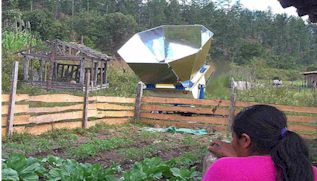 Rotary district 6450 started the
Temple Solar Project in 1997 to help people
to empower themselves through self-sustaining, solar micro-bakeries. Project
leaders arrange partnerships with Rotary clubs in receiving nations and
facilitate funding to purchase large Villager Sun Ovens®, produced by
Sun Ovens
International, Inc. Receiving clubs arrange for the delivery, setup and training
of crews to put the projects into effect. Since inception, the Temple Solar
Project has facilitated the start-up of more than 35 solar bakeries in Honduras,
Ghana, the Dominican Republic, Nepal and Angola.
Rotary district 6450 started the
Temple Solar Project in 1997 to help people
to empower themselves through self-sustaining, solar micro-bakeries. Project
leaders arrange partnerships with Rotary clubs in receiving nations and
facilitate funding to purchase large Villager Sun Ovens®, produced by
Sun Ovens
International, Inc. Receiving clubs arrange for the delivery, setup and training
of crews to put the projects into effect. Since inception, the Temple Solar
Project has facilitated the start-up of more than 35 solar bakeries in Honduras,
Ghana, the Dominican Republic, Nepal and Angola.
These bakeries serve multiple functions, depending on the needs of the particular community in which they are used. Numerous villages in Honduras are now home to trained villagers who manage bakeries that produce food for their communities and produce a small profit from sales to outsiders. A tiny bakery in the Dominican Republic, operated by a parish priest, is the sole source of baked goods for people living in nearby communities in Haiti. Elsewhere in the Dominican Republic, a school for the blind uses two large ovens to teach their students operating skills, self-sufficiency and business methods. In Angola, a school of 4000 uses a solar oven to produce 1000 meals per day for students.
During the current Rotary funding cycle it is projected that eight additional Village Sun Ovens® will be distributed.
See: Micro Sun Bakeries -- Creating Self-sustaining, Self-Propagating Micro-Enterprise
Contact: Walt Jenkins (Chairman, Temple Solar Project), tel: (630) 778-0125, fax: (630) 983-0239, e-mail: tvsl30@aol.com; Sun Ovens International, 39W835 Midan Drive, Elburn, Illinois 60119, USA. Tel: (800) 408-7919, fax: (630) 208-7386, e-mail: sunovens@execpc.com, web: www.sunoven.com
Another Busy Year for Free Methodists in Haiti
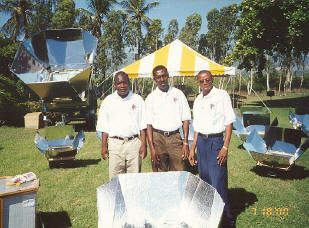 The following is based on a report by Mr. Hubert Paul Normil, Director of
Development for the Solar Energy Committee of the Free Methodist Church in
Haiti.
The following is based on a report by Mr. Hubert Paul Normil, Director of
Development for the Solar Energy Committee of the Free Methodist Church in
Haiti.
"This year we put on 33 demonstrations and 23 training sessions for a total of 218 participants. …
"Within the framework of our relationship with the Bureau of Mines and Energy, we participated in a workshop on ‘Energy Choices in the face of Environmental Problems’. … We presented different models of ovens and realized a cooking demonstration of rice with congo peas, cake and eggs. Some explanations on the way the ovens function was give to the participants and to the Prime Minister, Jacques Edouard Alexis, plus some interviews were given to some radio and television stations: National Radio and Television, Ginen, Vision Deux Milles (Vision 2000), and Télé-Eclair (Tele-Lightning). It was a favorable and profitable time for the Program, because one was able to note the presence of nearly all the actors working in the energy sector, and [solar] energy in particular.
"A seminar was organized in the Central Plateau … some kilometers from Pignon, at the invitation of the leadership of Haitian American Friendship Foundation (HAFF). … [They] requested a seminar on solar cooking techniques for the benefit of the leaders of the community groups. There were 13 participants at this seminar.
"We organized two seminars at the request of the general director of the Ministry of Religious Affairs, Mr. Gabriel Bien-Aimé. … These seminars had respectively five and eight participants. … In the workshop, they reflected and discussed the differences between the solar cooking method and the traditional method of cooking. The evaluation of the seminar revealed to us that they had all been satisfied, ready and motivated to share this technology with others and to become members of GAVOL. [Note: GAVOL, or Group Animateurs Voluntaires, consists of more than 200 volunteers spread throughout Haiti that organize demonstrations and seminars as needed.]
"We went to the United States Embassy … with the idea of organizing a demonstration. More than 20 organizations and institutions working in the domain of the environment, and in particular solar energy, were invited to take part: Quisqueya University, Haitian Christian Service, The Bureau of Mines and Energy, and the Federation of Friends of Nature (FAN) to name a few. Several foods were cooked: white rice, chicken, cake and eggs. These foods were reserved for the dinner offered to those attending. There were 30. This meeting permitted us to believe more in the future of solar cooking in Haiti. …
"We were invited … to give a seminar to be held at Coté d’Anse Rouge, more particularly at la Plaine de L’Arbre, located at Grand Carrénage. There were 21 participants, all members of the health program [of Parole et Action, or Words and Action]. … The choice of this zone to begin teaching about solar cooking was not haphazard by the leaders of Parole et Action; they took into account the needs of the areas concerned and above all the need for fuel. Their need is linked to deforestation which has already invaded these localities and which has begun the process of desertification. The inhabitants themselves declared that they have difficulty finding wood for cooking food. To resolve the problem, they are trying to dig in the ground to find the roots of trees already cut. According to them this practical and simple technology is welcome. There were four communities represented: Parc-Melon, Magasin, Morne Gilot and Grand Carrénage. In the workshop, the participants grouped themselves by area in order to reflect on and discuss the priority needs of their areas, the consequences of deforestation, any solutions they might have come up with, and the differences between solar cooking and the traditional method of cooking.
"A large demonstration was held on the grounds of the Chamber of Commerce with the combined efforts of ecological organizations and the United States Embassy, FAN, Christian Service of Haiti, Peace Corps, Quisqueya University, and the Free Methodist Church. There were representatives from several embassies: Japan, Canada, Germany, France, and some leaders from governmental and non-governmental organizations. One of the strong points of this demonstration was the total presence of the media. … All the television channels from the capital were there to cover this event. It was the first time in the history of solar cooking in Haiti that one was able to mobilize all the sectors of civil society and particularly the media. Three promoters of solar cooking from the United States took part in this demonstration: Mr. Paul Munsen, president of Sun Ovens International; Mr. Lowell Yoder, representing Free Methodist Friends of Haiti Organization (FOHO); and Mr. Herman Neusch. … More than 300 persons ate and about 50 solar ovens were displayed and used. …”
(Editor’s note: Mr. Lowell Yoder, mentioned above, along with his wife Marylin, founded the Friends of Haiti Organization (FOHO) in 1974 to raise funds and organize work teams to complete development projects in Haiti — primarily the construction of churches, schools, wells, etc. Much of their focus is now, however, on solar cookers. With FOHO funds, hundreds of family-sized solar cookers and a handful of village-sized solar cookers have been made available to Haitians. Of the larger cookers Mr. Yoder says, "We visited three orphanages and what a miracle to see them cook all the food needed and bake 50 loaves of bread an hour.” The Yoders will match any financial gift given to FOHO in support of solar cooking efforts.
Contact: Friends of Haiti Organization, P.O. Box 222, Holland, Ohio 43528, USA. Tel:+1 (419) 865-5555, fax: +1 (419) 865-5557, e-mail: lordblessyou@yodermachinery.com
"A demonstration was organized for the occasion of the Inter-American Water Day … sponsored by the World Health Organization (WHO), the Ministry of Public Health [and others]. The theme reserved for this year was ‘Each drop of water is a treasure, let’s use it with wisdom.’ The emphasis was put on rational management of water. The presence of our Program in this large demonstration showed to the participants that solar energy responds to their concerns. We made a demonstration which consisted of pasteurizing water and cooking eggs without water. Cooking eggs without water enters into the area of rational management of water which becomes more and more scarce, and the pasteurization by way of solar energy remains a natural method, which has no negative consequences on the environment. …
"At the invitation of the Ministry of the Environment, we participated at a big fair focusing on Haitian gastronomy. … We also took advantage of the space offered the Program to have a mini restaurant specializing in pizza, cupcakes and cookies. Two fundamental reasons caused the people to buy: the first was that the food was cooked in the sun, a strange concept. The only way to remove doubt was to taste in order to see if it was cooked. The second reason, it was considerably less expensive than other foods. It was normal for marketing purposes to reduce the cost of the items because the energy used was free. As a result, a strategic seminar was organized for 15 persons the following week.
"At the request of the director of Compassion International, Mr. Louis Edouard Lassègue, we organized a dinner prepared in the sun for the benefit of the personnel of that organization. There were more than 45 persons who attended this demonstration and who ate with satisfaction the prepared foods. … rice with peas, chicken, plantain, yams, potatoes and eggs. A speech on its use and the economic and environmental advantages of the solar oven was presented to the employees of Compassion. The same day, the director took advantage of the occasion to buy two ovens and the following day eight more for some employees. Now, solar energy is used at the home of some employees of Compassion, in particular at the home of the director in order to cook dry beans and some foods au gratin. …
"A seminar was held near Belladère with financial support from Jack Anderson, a Canadian promoter of solar cooking. There were 36 participants. All of the Belladère Commune were mobilized around the seminar. … The participants were truly motivated because they joyfully paid for their materials and brought food for the meal of the day. At the end of the seminar, they received the following materials: a panel [cooker] which they themselves made, a thermometer, a pot, an oven bag, a trivet and the appropriate documents. They also formed a committee in order to assure follow-up. …
"To conclude the year, we … organized a seminar on ‘the solar cooker and the environment.’ … We had 14 participants. … On this occasion, the participants constructed their own solar cookers and learned the appropriate techniques of cooking. … Foods cooked in the sun: rice with peas, chicken, fish, cornmeal with red beans, cakes, pizza, bread, coffee, tea and the pasteurization of water. …
"The Program was able, thanks to the multiplication effect, to attain one of its main objectives — that of multiplying and reinforcing its contacts with governmental and non-governmental organizations. This year we noted a large number of strategic, potential organizations for the promotion and spread of solar cooking in Haiti, in a word, for the future of solar cooking. …
"The [Project] hopes to train 10,000 persons in the next five years by training 2000 persons per year. This project will be accompanied by a little reforestation project of 6000 trees as a starter.”
Contact: Hubert Paul Normil, Eglise Methodiste Libre, Comite D’Energie Solaire, B.P. 994, Port-au-Prince, Haiti; Della Land, P.O. Box 15665 FMM, West Palm Beach, Florida 33416, USA.
Living tribute gifts have been given to SCI by:
Janette R. Coffing, Jenny Stowers, Kathleen M. Overton, Joyce E. Rasmussen, Helen Dadmehr, Rita Claverie, Jhanis L. West-Magana, and associates at Lisbon Elementary School in Sacramento, California to honor Linda Hayward upon her retirement from teaching, Susan D. Hopkins to honor Robin Song, and Eleanor and Clark Shimeall to honor Joan Rosen.
Memorial gifts have been given to SCI by:
Ron and Elaine Larson in memory of Walter Hahn, Eldon and Elaine Person in memory of Doug Augustine, Susan Okie in memory of Jane Earl, and Susan Okie in memory of Elizabeth Moses Meinicke.
Solar Cooker Review is published two or three times per year, with the purpose of presenting solar cooking information from around the world. Topics include solar cooker technology, dissemination strategies, educational materials, and cultural and social adaptations. From time to time we cover related topics such as women's issues, wood shortages, health, nutrition, air pollution, climatic changes, and the environment. Solar Cooker Review is sent to those who contribute money or news about solar cooking projects.
The suggested subscription price is US $10/year. Single copies are sent free to select libraries and groups overseas. We welcome reports and commentary related to solar cooking for possible inclusion. These may be edited for clarity or space. Please cite sources whenever possible. We will credit your contribution. Send contributions to Solar Cookers International, 1919 21st Street, Suite 101, Sacramento, California 95811-6827, USA. You may also send them by fax: +1 916-455-4498, or email: info@solarcookers.org.
Solar Cooker Review is compiled and edited by the staff of Solar Cookers International, with layout graciously provided by IMPACT Publications located in Medford, Oregon, USA. SCI is a 501(c)(3) nonprofit organization whose mission is to spread solar cooking to benefit people and environments worldwide.
Solar Cookers International
1919 21st Street, #101
Sacramento, CA 95811, USA
Tel: +1 916-455-4499
Fax: +1 916-455-4498
Email: info@solarcookers.org
Web: http://solarcooking.org
Board of Directors
- David Anderson
- K.C. Bishop
- Beverlee Bruce, Ph.D.
- Paul Funk, Ph.D.
- Christopher Gronbeck
- Gary Hursh
- Barbara Knudson, Ph.D.
- Virginie Mitchem
- Barby Pulliam
- Judith Ricci, Ph.D.
- Meredith Richardson
- John Roche
- Claude Thau
- Jim Uhl
- Elvira Williams
SCI’s mission is to spread solar cooking to benefit people and environments.
